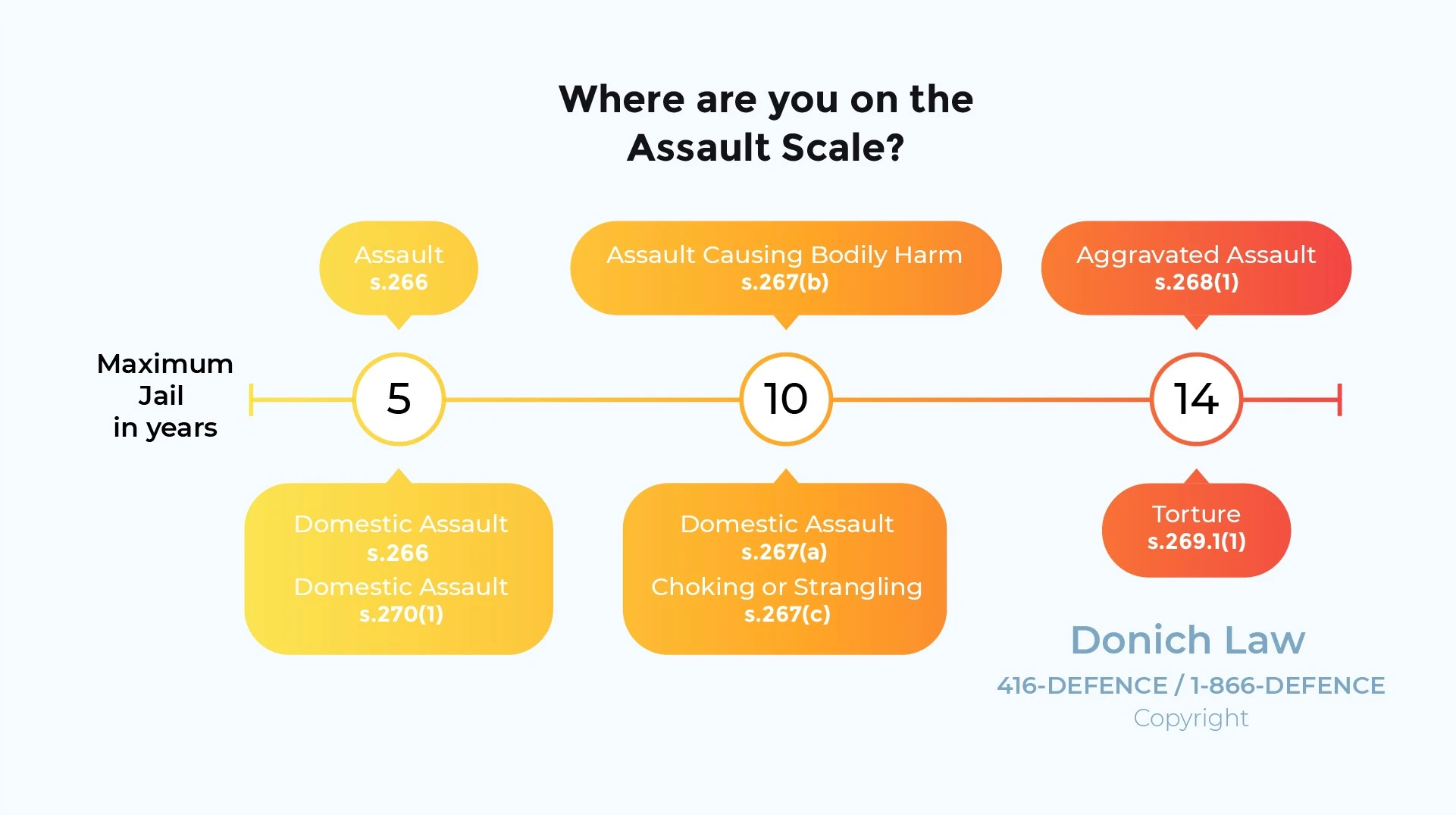
Defend Choking Charges
Frequently Asked Questions
Choking is a unique criminal offence under Canadian law. This is because there are two different sections of the Criminal Code that establish choking as a criminal behaviour. The first, under s. 246(a), deals specifically with offenders who using choking as a method to assist them in committing another serious crime. This is referred to as overcoming resistance and it applies to anyone who intentionally attempted to choke, suffocate, or strangle another person to render them unconscious or incapable of resisting. This charge may be laid in connection with a sexual assault, form of homicide or other significant crime.
How to Beat a Choking Charge?
There are several defences a person accused of a choking offence may rely on to avoid criminal liability. A potential defence for a choking charge under s. 276(c) is self-defence. Claiming self-defence allows a person to use force to protect themselves from the assault of another person. However, the force the defender uses must be proportionate, which means they cannot use more than the minimum amount of force required to successfully defend themselves. The same defence can be claimed in defence of a person’s property, so long as the defender legally owns that property.
Another defence to choking exists if the Crown cannot prove that choking occurred. This might be the case if witnesses believe they saw an accused person choke a victim, but the accused simply grabbed the front of the victim’s shirt. Although the accused may still be liable for an assault in that case. Finally, if the Crown cannot prove that an offender choked someone to commit another indictable offence, they cannot be convicted under s. 246(a). They may however still be liable under s. 267(c). Where the Crown fails to meet their case at trial, the accused will be acquitted even without presenting any evidence in their defence.
The second form of criminal choking is set out under s. 267(c) of the Code. It is an offence connected to assault with a weapon or causing bodily harm. This offence focuses only on the action of the choking itself rather than what the offender meant to accomplish by choking the victim. For s. 267(c) to apply, there must be an allegation that the accused choked, strangled, or suffocated the victim. For example, if Person A and B are in an argument, and A decides to close his hand around B’s throat and begins choking him, but stops the altercation and walks away, it is likely that A would be charged under s. 267(c).

- CP24: Civil Sexual Assault Lawsuit at St. Michael’s in Toronto.
- Global News Morning Show: Sentencing Arguments in Assault case of Dafonte Miller.
- Breakfast Television: Role of Mental Health in Court Proceedings.
- Global News National: Bruce McArthur will not serve consecutive sentences.
- CBC Radio: Interview with Mayor John Tory and Jordan Donich on CBC Radio.
- CTV News National: Handgun ban supported by majority of Canadians: Nanos survey.
- Global News: How difficult is it to get a legal handgun in Canada.
- CP24: Sentencing Hearing for Chair Girl.


Will a Person Accused of Choking be Held for Bail?
Whether an accused person is held for bail depends on the circumstances of the offence they are charged with once they have been arrested. Both forms of choking under the Code are serious criminal offences, but they can still be applied to a wide range of cases, some of which are less serious than others. The police will make the decision on whether an accused person should be held for bail. In making that decision, they will examine the accused’s criminal history as well as the facts of the case. These facts include who the victim of the offence was and whether they would be at risk if the offender was released without conditions. This is particularly relevant where the choking occurs in a domestic abuse situation. In those cases, the police will consult the victim to determine if they have any concerns for their safety.
If the police are not satisfied that the accused can be released without conditions, they will hold them for a bail hearing. At that hearing, a judge will review the facts of the case and hear arguments from the Crown and defence on what conditions, if any, the accused should be made to follow if they were to be released pending their trial. These conditions can range from a no-contact order with the victim to requiring the accused to reside with a person who will ensure they comply with their bail conditions, known as a surety. Imposing a surety is the most restrictive bail condition and is reserved for cases where the court believes it is necessary to ensure the accused will comply with their terms. Decisions on bail terms are made based on three principles. Whether it is believed the accused will voluntarily attend all set dates for their case, the likelihood that the accused may reoffend, and whether releasing the accused would undermine public confidence in the justice system. It is common for persons accused of choking to be held for bail because of concerns related to the second principle.
Jail Sentences for Assault Charges in Canada

How Does the Crown Prove Choking?
For an offender to be convicted of a criminal offence, the Crown must prove the elements of that offence beyond a reasonable doubt. Each offence shares three common elements that must be proven in addition to the offence-specific matters. They are the identity of the offender, the date and time of the offence and the location where the offence occurred. Once the common elements have been proven, the Crown can deal with the unique aspects of the choking offence.
As there are two offences related to choking within the Code, the elements that the Crown must prove will be similar for both sections. Under s. 267(c), the Crown must prove that the offender assaulted the victim, and that they chose to choke, suffocate, or strangle them by cutting off their airflow by force. The offence under s. 246 first requires proof that the offender attempted to choke the victim or took some other action that was meant to choke the victim. Then it must be shown that the offender attempted to render the victim unconscious or incapable of resistance. Finally, it must be shown that the offender used choking to enable them to commit an indictable offence such as sexual assault or homicide. It is worth noting that the Crown will require evidence to prove a choking offence occurred. However, given that the offences may often occur behind closed doors, physical evidence might be difficult to acquire or may not exist in every case. In many cases, the Crown may rely on the testimony of the victim as the only available evidence to prosecute the accused. Testimony from the victim alone is sufficient to convict the accused if the court finds the testimony to be reliable, and credible.
How to Defend Assault Charges
Will an Offender go to Jail for Choking?
The exact sentence an offender will receive depends on the facts of their case and the choking offence they were charged with. Section 267(c) choking is considered a hybrid offence. This gives the Crown the choice to prosecute a case by indictment or by summary conviction. A Crown will elect to proceed by indictment where the allegations are serious in nature, or where the allegations occurred more than one year before the accused’s arrest. The Crown will elect summarily in all other cases.
The maximum sentence for choking under s. 276(c) is 10 years imprisonment where the Crown proceed by indictment. Where the Crown proceeds by indictment, there is a maximum penalty of two years less a day imprisonment and/or up to a $5,000 fine. Aside from their main sentence, an offender will likely also have secondary consequences imposed on them by the court which are known as ancillary orders. Different ancillary orders can be applied to different offences, but choking, regardless of the type will carry a mandatory DNA order. Section 267(c) choking may also lead to a weapons prohibition.
Choking to overcome resistance pursuant to section 246(a) of the Code is considered a straight indictable offence, which means the Crown does not have the option to proceed summarily. As a result, a person convicted of that offence could face life imprisonment. Alongside a DNA order, the Crown has the option to ask the court to issue a SOIRA order as well, particularly if the choking was connected to a sexual offence.
These potential penalties reflect the seriousness of choking and the harm it can cause. It is also a sad reality that many choking offences occur with in the context of domestic relationships. The vulnerability of the people in those relationships helps to explain the strict penalties set out in the Code. The increasingly common connection between choking and domestic violence is part of the reason why the Code was updated in 2019 to establish choking as its own type of offence. The rationale behind this decision included studies that show that instances of choking result in a significantly higher chance of the victim’s death. Therefore, the law had to be updated to reflect the nature of this threat.
Law Newbie is a free AI research assistant that can help you safely answer questions about criminal law.




Recent Cases
R. v. D.B., 2022 ONSC 2854
This Ontario Superior Court of Justice case is an example of the sentencing process involving a s. 246 choking offence. In this case the offender was charged with multiple sexual assaults against three different women. It was found that the offender had choked one of the victims to commit the sexual assault. The offender was known to all the victims as they were connected through their shared drug use. The offender used this connection to prey on the vulnerabilities of the victims and enable him to sexually assault them.
Given the number of offences and the victims, the offender faced a significant sentence. He received 18 years imprisonment for all the charged offences. Alongside the main sentence, the offender was issued several ancillary orders including a DNA order, a SOIRA order and a weapons ban.
In addressing the choking aspect of these offences, the court referenced another case with similar facts, relying on the following quote. “Lofchik J. found that Simas-Mamani had ‘clearly endangered [his victim’s] life, as the difference in outcome between unconsciousness, brain damage, and death may be only a matter of a few additional seconds of pressure’” [at para 77] This quote clearly demonstrates the seriousness of choking to commit another offence. It is obvious that an offender who chooses to choke their victim deliberately makes that decision without considering the risk they are subjecting the victim to. Given the disastrous outcomes that choice might lead to, the treatment of choking under the Criminal Code is well-justified.
R. v. Martin, 2021 ONSC 6964
This Ontario Superior Court of Justice case was an appeal decision for the sentence received following the offender’s guilty plea. The case is an example of how courts treat choking as a form of domestic violence. Although the offender pled guilty to assault causing bodily harm under s. 246(b) instead of assault via choking under s. 246(c), the facts of the case show that the offender clearly choked his partner to the point of unconsciousness during an argument that turned physical. The sentence issued at first instance was a suspended sentence with twelve months of probation. The Crown appealed that sentence on the basis that the sentence was too light given the facts of the case, even if the offender pled guilty and was a first-time offender.
The appeal court agreed with the Crown and overturned the original sentence. In its place, a 60-day sentence was issued plus the original probation order. The court found that the original sentence put too much weight in the offender’s first-time offender status, guilty plea, and rehabilitative efforts. Reflecting on other cases with similar facts, the court determined that a jail sentence is necessary even where an offender’s choking of a domestic partner does not result in the victim’s unconsciousness. The fact that the original sentence did not fit the seriousness of the offence does not discount the other factors that work in the offender’s favour, so those were still accounted for when the new sentence was issued.












